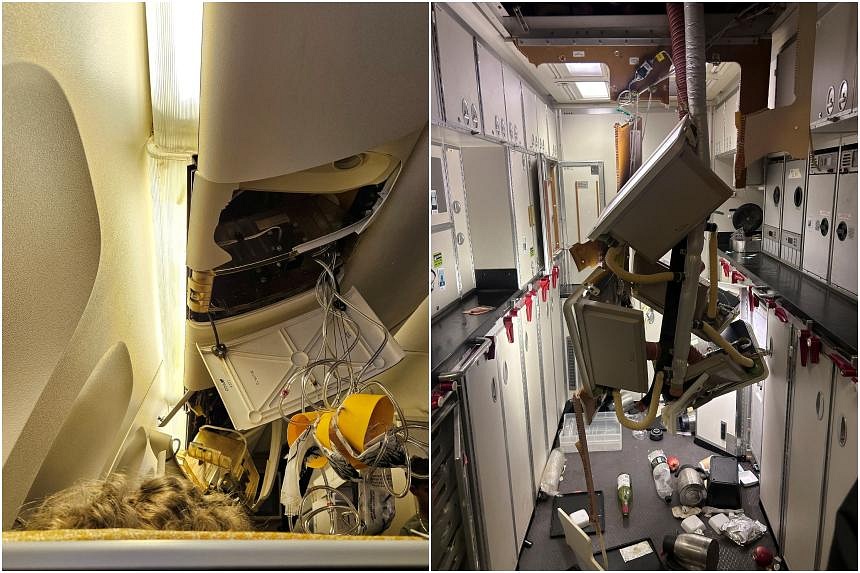SQ321 incident: What causes turbulence and is climate change making it worse?


SINGAPORE – A Singapore Airlines flight had to make an emergency landing in Bangkok on May 21 after encountering sudden, extreme turbulence, which resulted in one death and dozens of passengers injured.
The circumstances surrounding the incident on SQ321 are under investigation, and one expert said it was one of the worst he has seen in his 30 years in the industry.
While it is not uncommon to encounter in-flight turbulence, such episodes can have severe consequences.
Between 2009 and 2022, America’s Federal Aviation Administration (FAA) recorded that 163 passengers and crew members were seriously injured by turbulence on aircraft registered in the United States.
Here is what you need to know about turbulence.
1. What is turbulence?
Professor of urban climatology Matthias Roth described atmospheric turbulence as irregular, chaotic and unpredictable motions in the airflow.
Turbulence can be caused by storms, mountains, weather fronts and strong air currents such as jet streams, said Dr Roth, who is from the department of geography at the National University of Singapore (NUS).
Turbulent motions are usually not visible, he noted. This particular type of turbulence, which is often called clear air turbulence, is caused by changes in wind speed, air temperature or pressure over short distances. They are difficult to avoid because they are not directly visible, are hard to predict and do not show up on a weather radar.
Associate Professor Steve Yim from the Asian School of the Environment at the Nanyang Technological University (NTU) said turbulence can be caused by wind shear – a sudden change in wind speed and direction due to differences in air temperatures at different altitudes.
The World Meteorological Organisation called wind shear a “major hazard” for aviation, especially when operating at lower altitudes.
AccuWeather, an American weather forecasting firm, has posited that rapidly developing thunderstorms near the flight path of SQ321 likely contributed to the violent turbulence.
Mr Dan DePodwin, AccuWeather’s senior director of forecasting operations, said a review of satellite and lightning data clearly shows explosive thunderstorm development close to the flight path.
“Developing thunderstorms often have strong updrafts, a zone of upward moving air that rises very rapidly, sometimes at more than (160kmh) and can leave pilots with little time to react if it occurs directly in front of the plane,” he said.
“It’s possible the plane encountered a situation like this which thrust the plane up in altitude, causing a severe change in altitude in a short amount of time.”
2. How common are injuries related to turbulence?
America’s National Transportation Safety Board (NTSB) reported that more than a third of all airline incidents in the US from 2009 to 2018 were related to turbulence, most of which resulted in one or more serious injuries but no damage to the plane.
Fatalities from encountering turbulence in flight are rare. None was captured by the FAA between 2009 and 2022.
But there were 129 crew members and 34 passengers who were seriously hurt due to in-flight turbulence in this period.
They sustained injuries that required hospitalisation lasting more than 48 hours, such as fractures, severe haemorrhages and damage to internal organs.
3. Is turbulence increasing due to climate change?
In a study published in 2023, Dr Paul Williams, a professor of atmospheric science at the University of Reading, said severe clear air turbulence over the North Atlantic Ocean had increased by more than 50 per cent from 1979 to 2020.
Dr Roth from NUS said the increase in clear air turbulence had to do with climate change, which alters the jet stream.
Jet streams are the relatively narrow bands of strong winds that occur at higher altitudes. This is typically the height at which commercial aircraft cruise because the planes can fly more efficiently.
Prof Yim, who is also the principal investigator at NTU’s Earth Observatory of Singapore, said air temperature increases at different rates, depending on the distance from the ground. This uneven warming leads to turbulence as the air moves at different speeds.
“The projections are that with climate change, clear air turbulence might increase by a factor of two or three,” he said.
Dr Winston Chow, a professor of urban climate at the Singapore Management University, noted, however, that the 2023 study does not mention the situation in South-east Asia or the Andaman Sea, where SQ321 encountered the turbulence.
A 2021 study by the University of Arizona found that the position of the North Atlantic jet stream could move out of its range of natural variability by as early as 2060, if the level of greenhouse-gas emissions does not come down.
The study said this will have “potentially drastic weather-related consequences for societies on both sides of the Atlantic”.
4. How can passengers keep themselves safe?
Data from the NTSB, which is the agency for civil transportation accident investigations in the US, showed that from 2009 to 2018, the most commonly reported activity for passengers who were injured in a turbulence-related accident was when they were using, waiting for or walking to or from the toilet.
The next most commonly cited activity was while they were seated without their seat belts.
Experts said passengers should keep their seat belts fastened at all times.
Retired commercial pilot Steven Khoo said the pilots and cabin crew are always doing their best to keep passengers safe, and passengers should also be thinking about their own safety.
Just as drivers and passengers stay belted up in a car, it is logical that those travelling in an aeroplane should also be buckled in, he added.
Mr Michael Daniel, who had served as a safety inspector and an accident investigator at the FAA, said that based on the pictures of the aftermath of the turbulence on SQ321, the accident was among the worst he had seen in 30 years.
Mr Daniel, who is the managing director of an aviation consultancy, said: “It is a good safety practice to always be diligent and stay buckled up because you never know what can happen next.”


No comments
Share your thoughts! Tell us your name and class for a gift (: